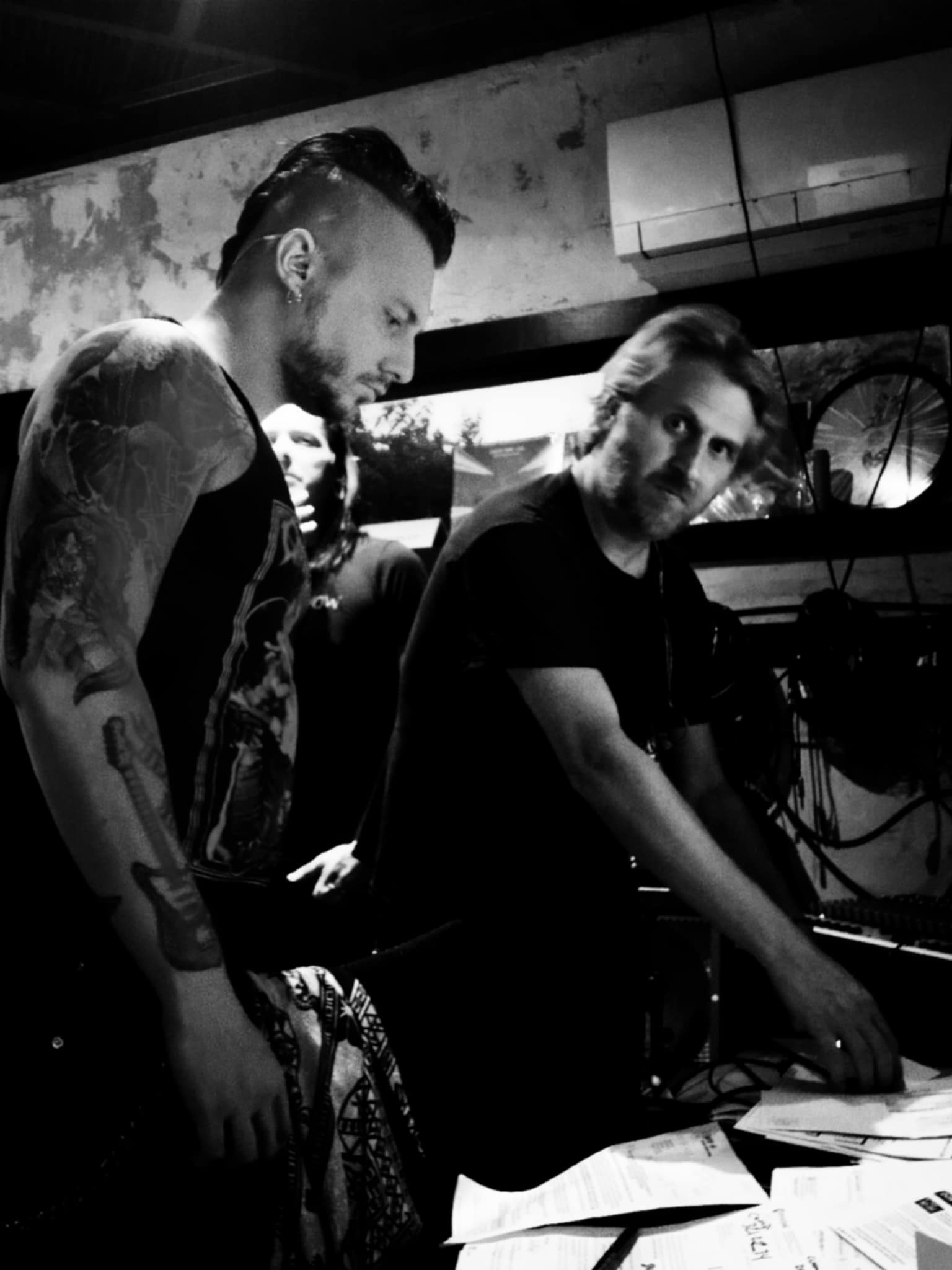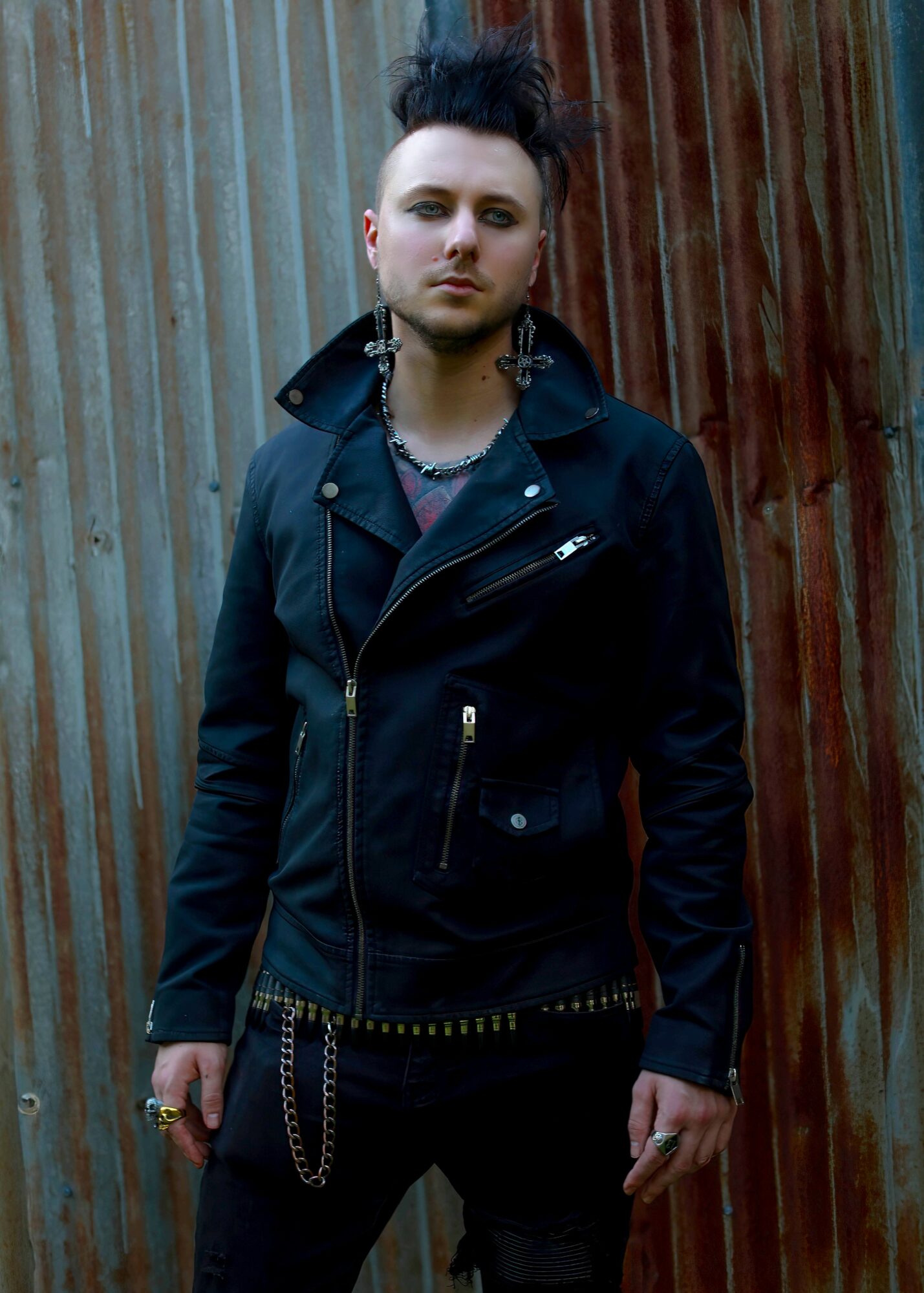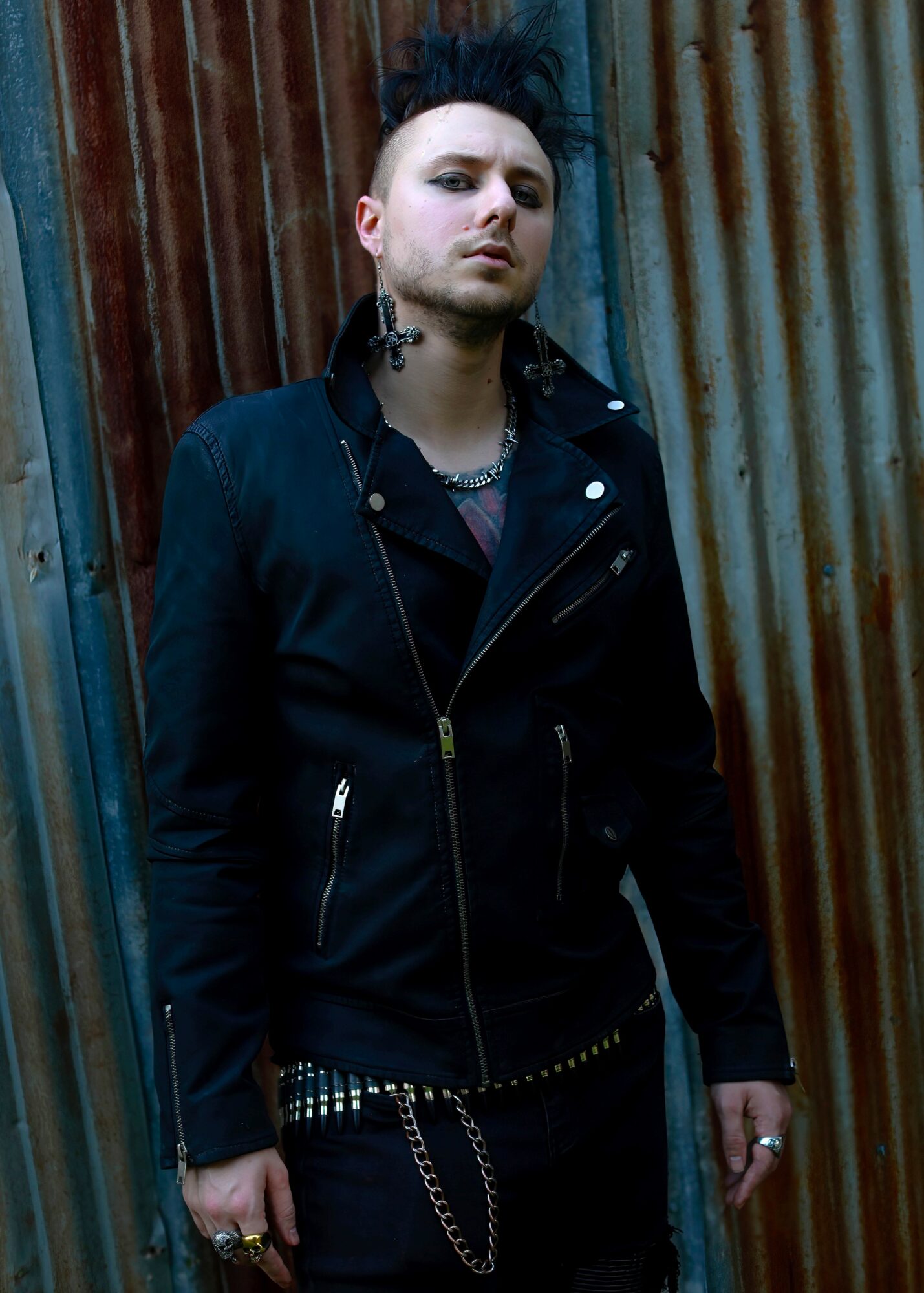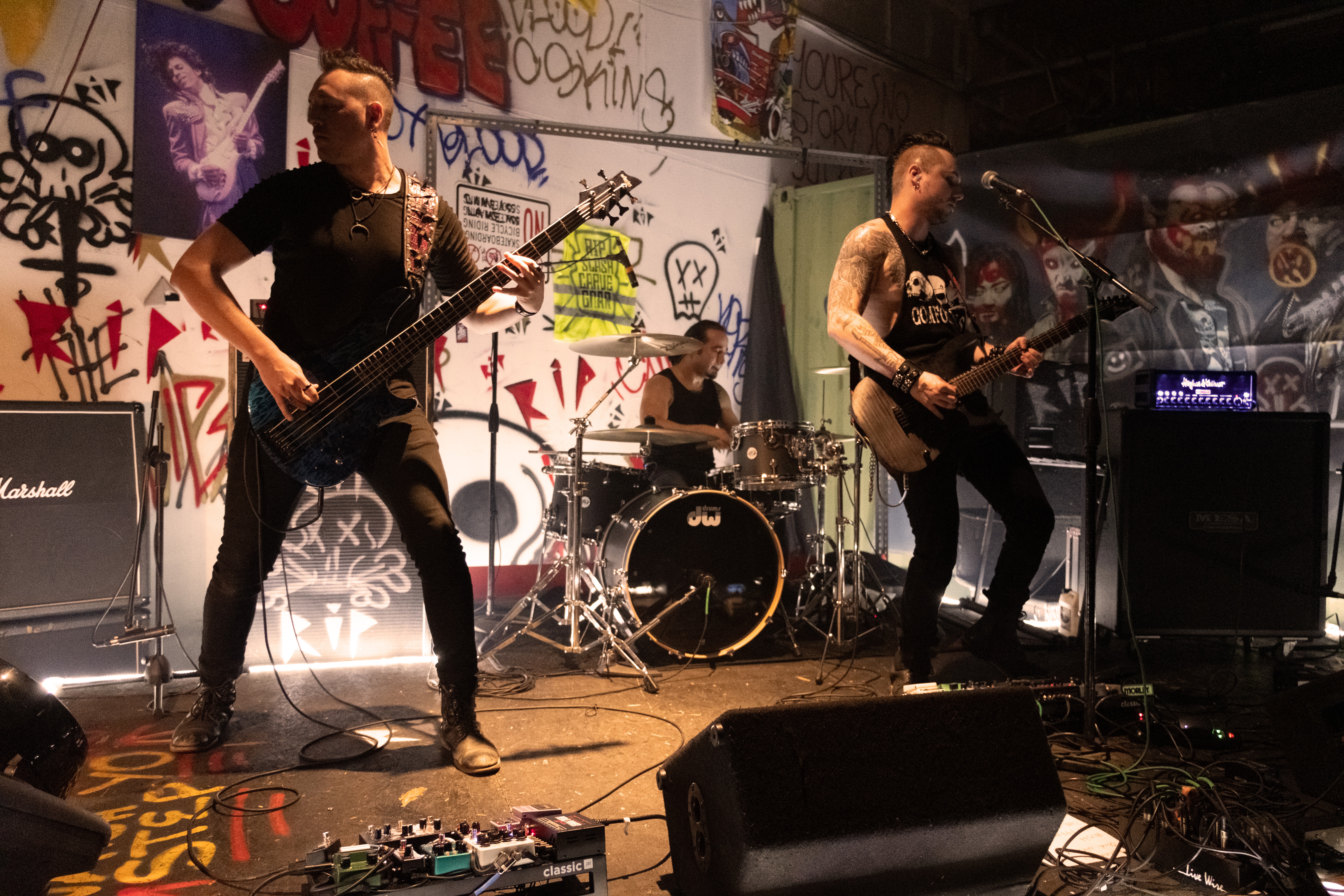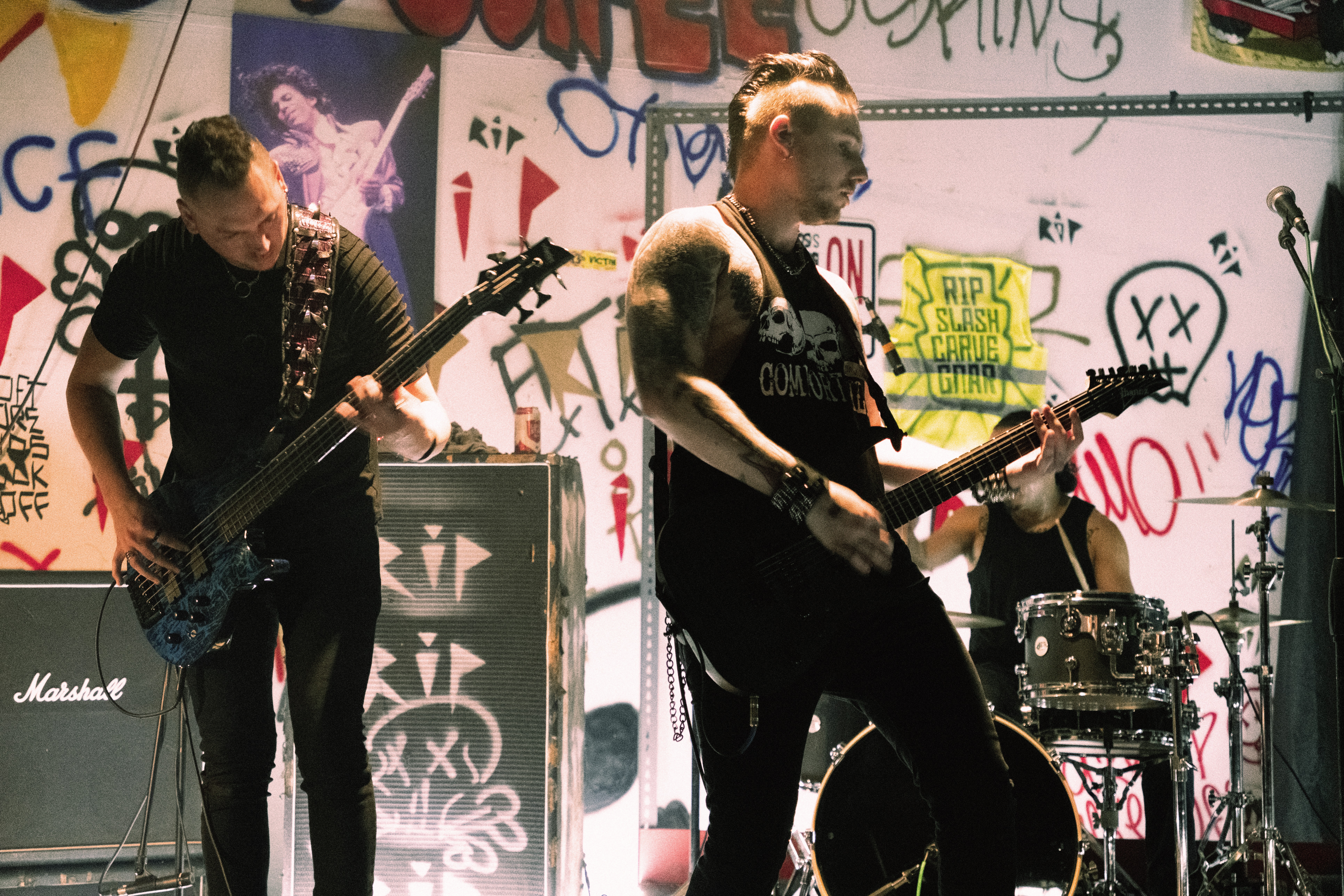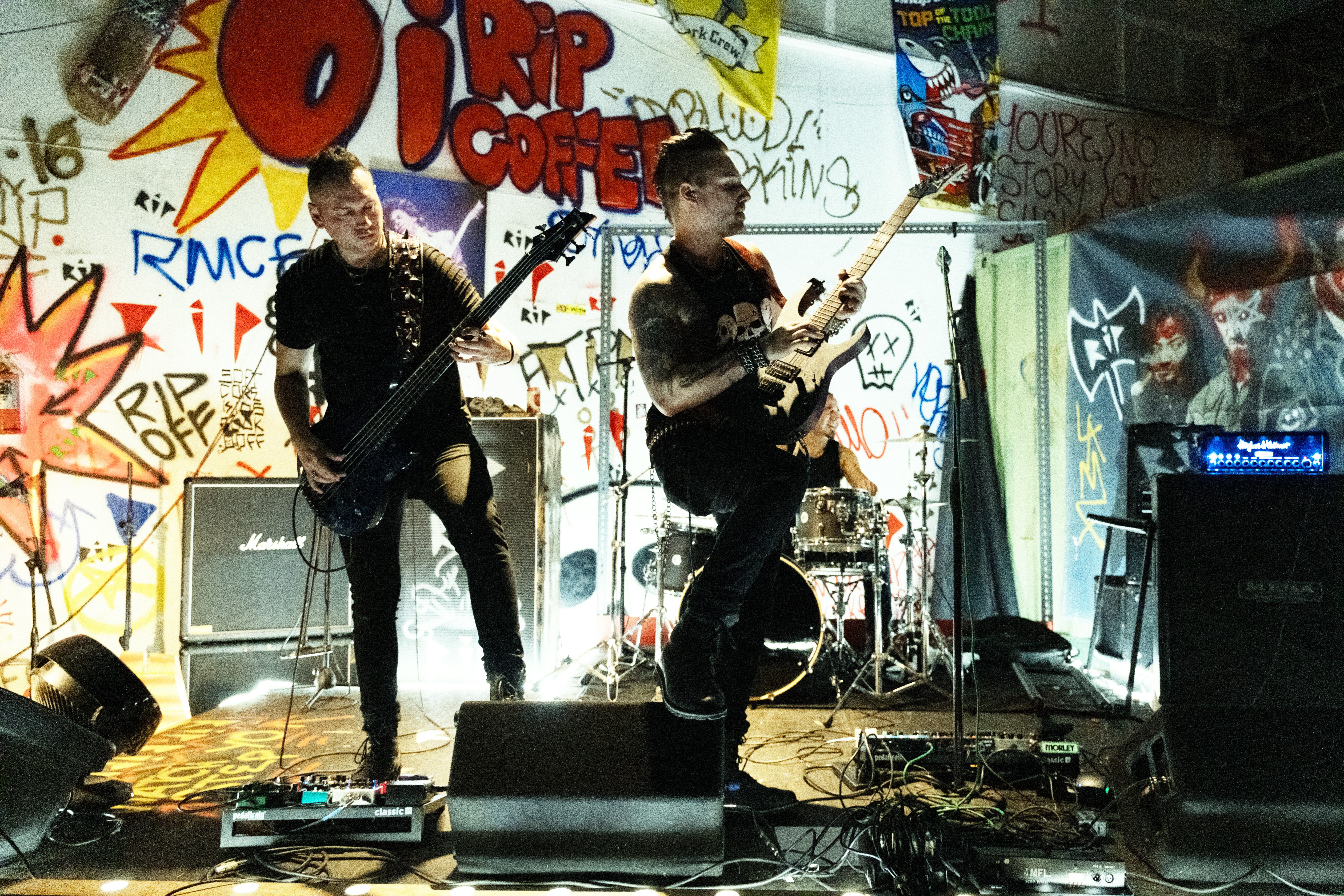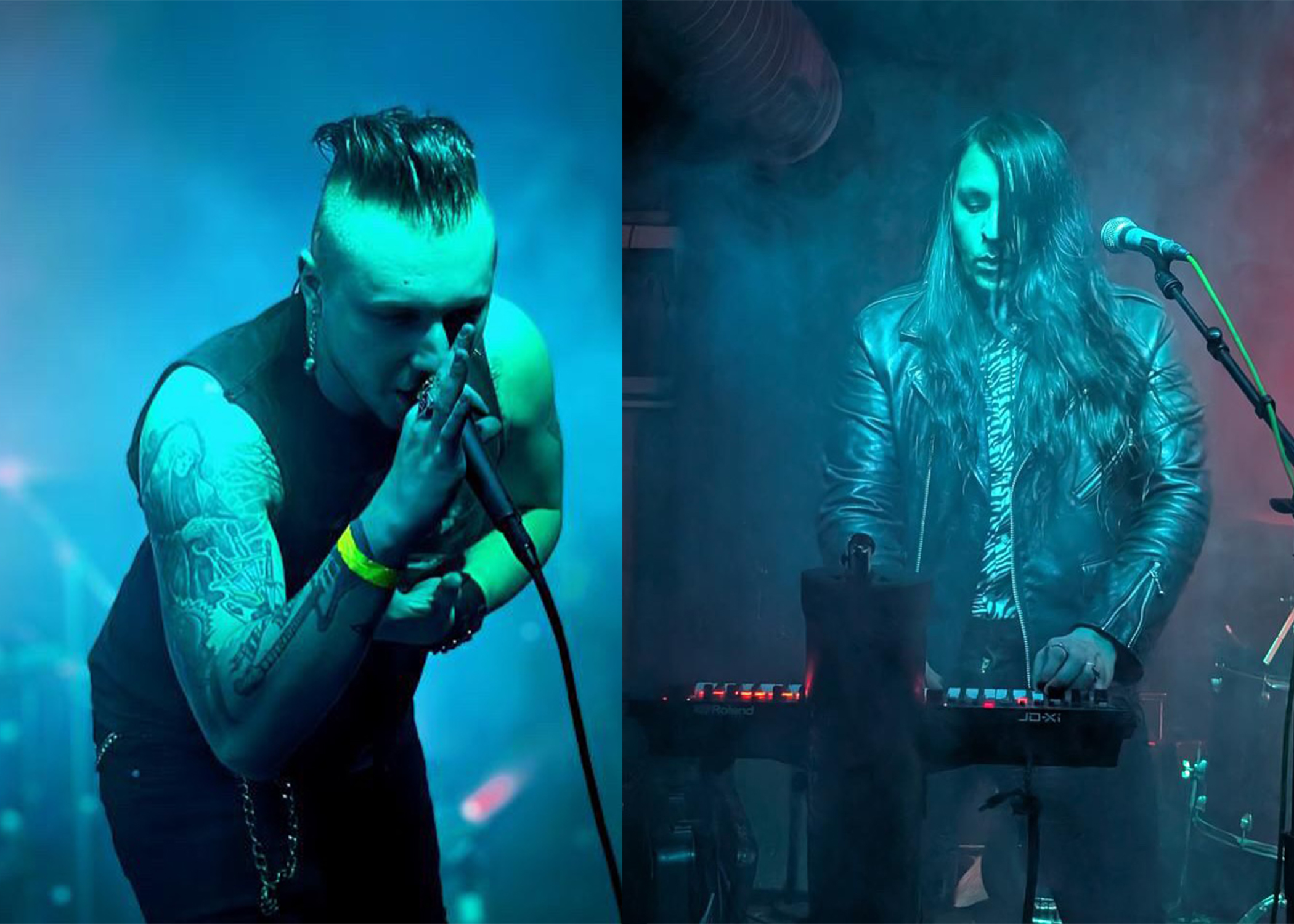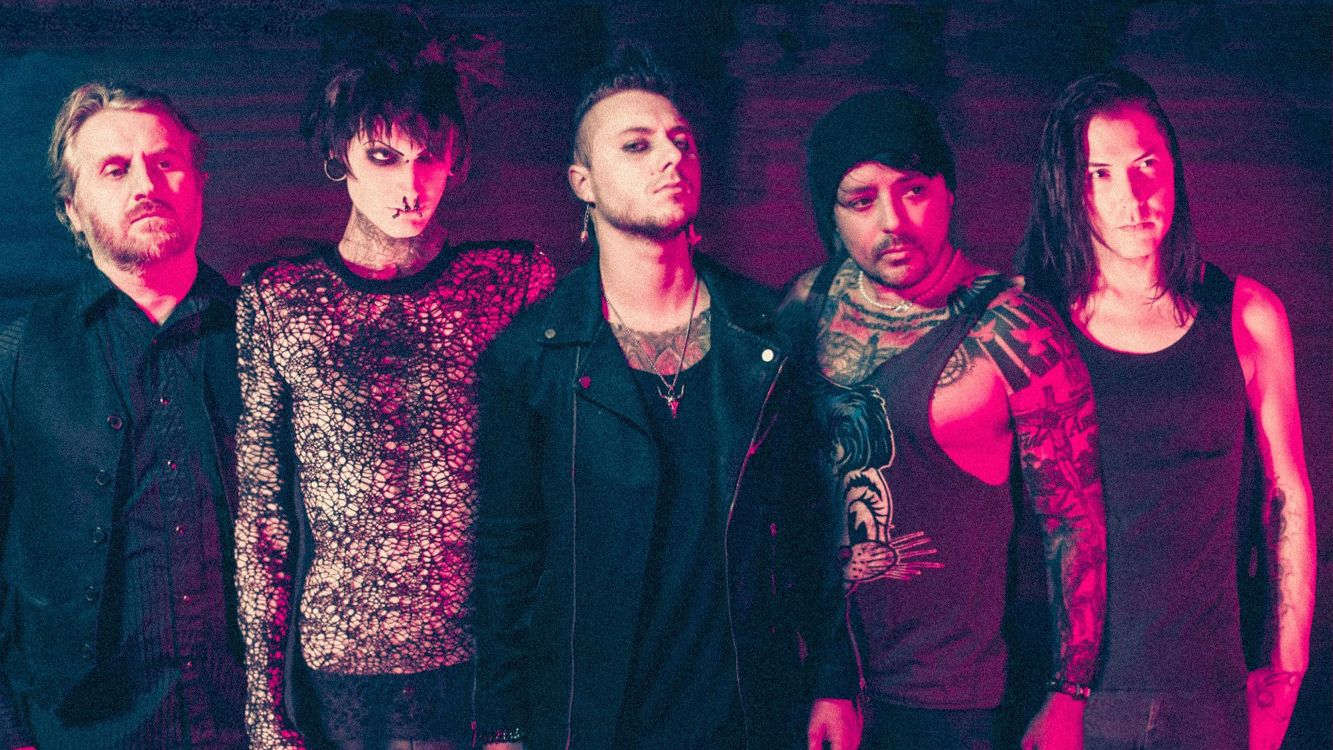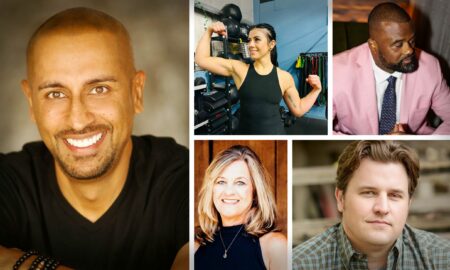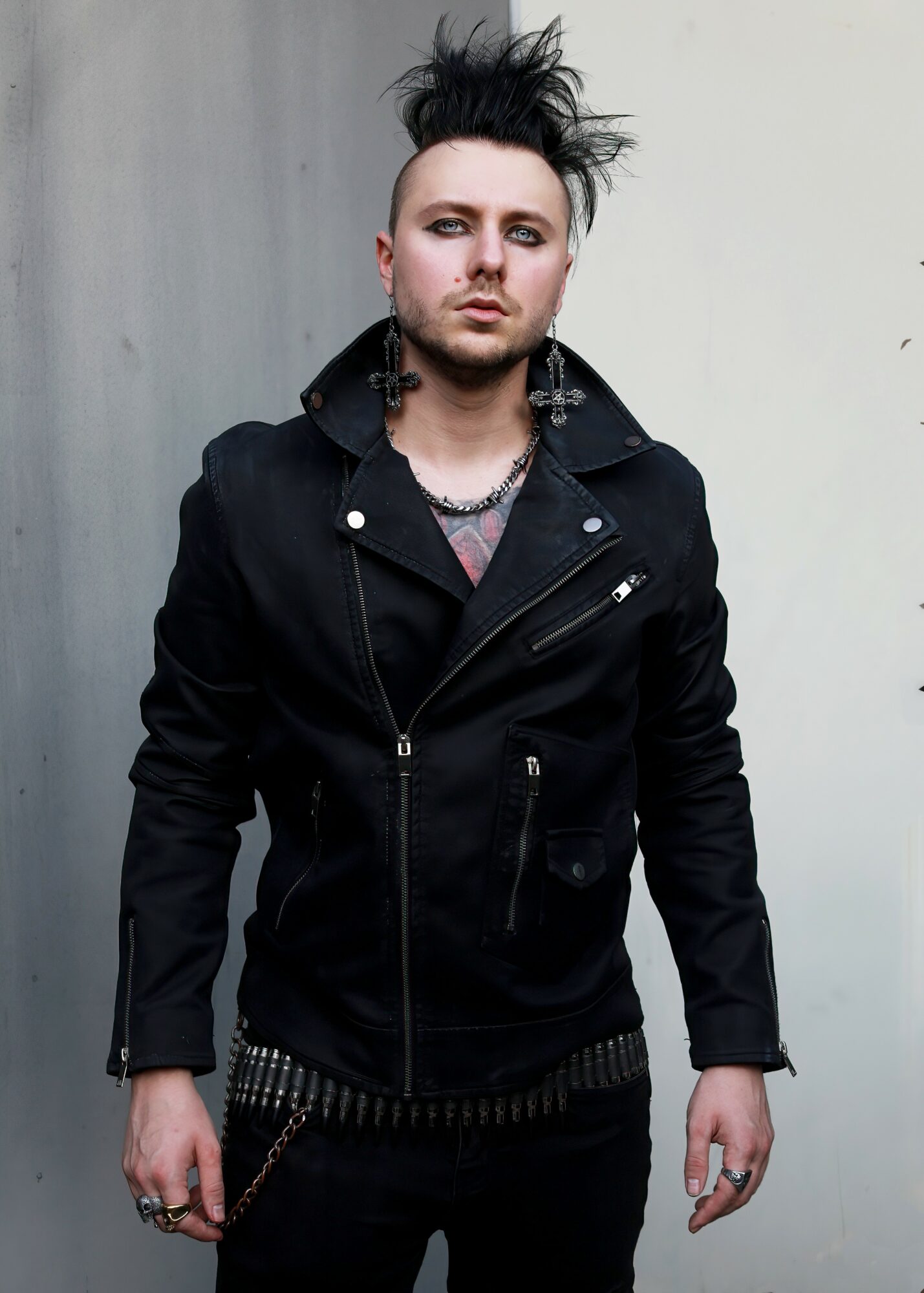

We recently had the chance to connect with Ethan Stafford and have shared our conversation below.
Ethan, so good to connect and we’re excited to share your story and insights with our audience. There’s a ton to learn from your story, but let’s start with a warm up before we get into the heart of the interview. What is a normal day like for you right now?
Most late nights begin with horror novels. Right now it’s Fever House by Keith Rosson, chaotic and surreal in a way that lingers with me. Those kinds of books bleed into my lyrics for Sinclair Noire, giving me cinematic images to pull from. My desk is usually a wreck of horror novels, retro ’90s punk and new wave zines, guitar picks, recording gear, and vinyl stacked by my turntable. I’ll flip between my digital library and records; lately I’ve been revisiting Tones on Tail’s “Pop” on 4AD, which has become a touchstone for me.
This week, the band’s locked in rehearsal, finishing the last songs for our next album. It still has that deathrock guitar bite and post-punk bass drive, but we’ve been layering harsher synths and electronic percussion, pulling Sinclair Noire into a grittier, more industrial shadow for the 2026 release. Fans and critics have said we bring a fresh edge to darkwave, carrying a spark from the old 4AD “Positive Punk” era while still sounding urgent and new.
On Saturdays I drive up to our rehearsal space in North Austin and put in a full day. After that, I’ll usually head to South Congress to work with Curtis Hart from Th3 L3p3rs at his studio. We’ll track new ideas, experiment with synth layering, or record drums. It’s a cycle of reading, writing, rehearsing, and recording, keeping Sinclair Noire less like a band and more like a world I live inside every day.
I want this next record to have a fresher sound, while also building on our culmination of sounds we’ve blended, including everything from synth-punk to industrial. I want it to feel like the score to a fever dream; something unsettling but strangely seductive, where every song drags you deeper into Sinclair Noire’s world. Listeners resonated with that bold take in our latest LP, Bone Orchard. I think this next record can build further on those explorations.
Can you briefly introduce yourself and share what makes you or your brand unique?
I’ve been writing and recording music since 2015, but it wasn’t until I moved to Austin that I really discovered my main project, Sinclair Noire. Austin gave me a space to sharpen my ideas and test them in front of audiences that crave intensity and originality. I’d already been collaborating with other artists, but Sinclair Noire was where my vision for post-punk and deathrock came into focus. From there I toured and also joined projects like Most Modern and Th3 L3p3rs, which challenged me in different ways and expanded my sound palette. Fans connected with Sinclair Noire because it wasn’t just nostalgia for goth or punk; it was about pulling those influences into something raw, cinematic, and politically charged, which struck a nerve in the Austin circuit. People are searching for answers right now, and hopefully my music offers consolation, or at least provokes listeners to think. Post-punk was artistic because the scene valued experimentation, aesthetics, and cultural critique as much as the music itself. It wasn’t escapism; it was art as confrontation.
When it comes to building the next Sinclair Noire album, I approach it like constructing a world from the ground up. Every synth line, guitar riff, and drum pattern is deliberate, chosen to create tension, mood, and cinematic depth. In the studio, I experiment constantly, layering harsher electronic textures, pushing the guitars into jagged, industrial territories, and sculpting the basslines to drive both rhythm and atmosphere. It is not just about making songs, it is about creating an immersive experience that reflects the darkness and intensity of the world I explore in my lyrics. Each track is a statement, a confrontation with ideas, emotions, and society itself, carried forward from the post-punk ethos that inspired me. By the time the record is finished, I want listeners to feel as though they have stepped inside the world of Sinclair Noire rather than just pressed play on another album.
The same hands-on, experimental approach carries over into my other projects. With Most Modern, the focus is on synths and vocals, exploring textures and melodies in a more intimate, precise setting that Joey Olivares is creating atmosphere-wise. Our upcoming record “Acid Rain” is really going to drive heavier coldwave influenced synths and post-punk guitar and vocals. Th3 L3p3rs is a high-volume five-piece, where Curtis Hart, our drummer and studio engineer, drives both layering and stagecraft, pushing the band to create immersive, intense performances. Simon Diaz is our synth player and directs our music videos with a really refreshing modern take on dark alternative music. Our new bassist Sterling is learning the approach to our live show direction really well, and our guitarist Griffin Wright is really helping coach him from a producer’s standpoint. In every project, I approach recording and performance as world-building, whether it is crafting cinematic darkness for Sinclair Noire, sculpting minimal synth landscapes in Most Modern, or generating the raw energy and atmosphere of Th3 L3p3rs. Each context challenges me in different ways, but the goal is the same: to create music that feels alive, confrontational, and unforgettable.
Amazing, so let’s take a moment to go back in time. What part of you has served its purpose and must now be released?
I think the part of me that has served its purpose and now must be released is the part that prioritized pleasing authority and overextending myself to meet others’ expectations. For years, I pushed past my own limits to conform to systems that didn’t recognize or reward my contributions, and while that discipline taught me resilience and accountability, it also came at the cost of my mental health and creative energy. Letting go of that part means I no longer define my value by compliance or exhaustion, and I can approach challenges from a place of integrity rather than fear of judgment.
I’ve had risky experiences, romantic explorations, dark chapters of facing personal battles, and have probably grown from a few fatal flaws. Tackling all of those challenges while my music evolved is something you can hear within the music itself. This makes the music’s impact much deeper.
Releasing that part allows me to embrace the aspects of myself that truly drive impact: creativity, curiosity, and authentic collaboration. I can focus on bringing unique perspective and thoughtful problem-solving to my work without compromising my boundaries or well-being. In letting go of the old patterns of overcommitment and self-erasure, I’m opening space to contribute more effectively, sustainably, and meaningfully.
What have been the defining wounds of your life—and how have you healed them?
Well, my father left my family at a very young age, and my mother died of a drug overdose at 15. I was sleeping on friends’ couches, playing in bands by 16 and 17. There were rowdy nights downtown; I was always tagging along at my mother’s friends’ house parties. Sleaze, drinking, vices, and the punk rock lifestyle were all part of the game at a very young age, but I was also forced to conform with my grandparents’ expectations. They wanted a very clean-cut, religious grandson, and that was not who I was. I found solace in rebellion, even if it was dancing with fire. Was my mother a good role model? Probably not. Were there street smarts to be gained from being thrust into that world young? Absolutely.
Those experiences left their marks, of course, including loss, instability, and a sense of having to navigate life on my own before I was ready. But in that chaos, I learned resilience in ways most people do not get taught in classrooms or homes. I discovered the value of self-reliance, the importance of forging authentic connections, and the power of channeling raw experiences into creativity. Music, art, and the communities I found around it became not just an outlet, but a lens for understanding myself and the world. Healing for me was not about erasing the past; it was about integrating it, learning from the fire I danced with, and using those lessons to shape a life that honors both the struggles and the survival skills I gained along the way.
At the same time, I was discovering the world through camcorders and early CRT televisions, filming friends, band practices, and nights out, then watching it all back on those small, flickering screens. That hands-on experimentation taught me not just technical skills, but also how to observe, interpret, and frame experiences, and how to make sense of the chaos around me. I was part of that cusp generation, still living with VHS tapes, skateparks, and mixtapes, but before social media, smartphones, and life apps reshaped everything. Navigating life required intuition, memory, and real-world experimentation. There was no algorithm to guide behavior or validate choices. It was messy, it was raw, and it demanded attention, creativity, and a willingness to fail. Those are lessons that have carried forward into how I approach music, work, and relationships today.
Next, maybe we can discuss some of your foundational philosophies and views? What important truth do very few people agree with you on?
I think one important truth very few people agree with me on is that humans are inherently wild, chaotic, and deeply connected to the same primal forces that drive other animals. Most people prefer to see themselves as rational, civilized, and separate from that rawness, but I see it as a central part of our nature. I don’t shy away from the darkness in life, the gritty edges of society, mortality, and uncomfortable cultural truths, because facing them honestly is part of understanding who we are. At the same time, I’m not dismissive of the esoteric or mythic side of ourselves. Art, music, and ritual are all ways of engaging with those hidden dimensions, of exploring archetypes and symbolic truths. For me, the act of creating Sinclair Noire and my other projects is inseparable from that journey of self-discovery. It’s about confronting the chaos, understanding it, and translating it into something that can move, challenge, or inspire other people.
Understanding our primal nature is not about glorifying violence or chaos, but about recognizing the forces that shape our thoughts, desires, and behaviors. When we confront these truths honestly, we open the door to deeper self-awareness and mythic self-discovery. Ritual, art, and music are ways to engage with these hidden layers, to transform instinct and raw emotion into something symbolic and meaningful.
Who’s to say other animals aren’t just as mythical as we are? So much of the symbolism and archetypes we use in our stories comes directly from them, from predators and prey to birds and insects. They embody traits, instincts, and energies that we project onto our own myths, but perhaps they also carry their own inherent narrative power. In my upcoming Sinclair Noire album, the new song “The Hand is a Talisman” dives into that kind of animalistic absurdity, exploring the uncanny, instinctual, and symbolic in ways that blur the line between human and animal. The second single we plan on releasing, “Congo War,” explores the geopolitical crisis of resource exploitation, and the M23 rebel factions warring in the Democratic Republic of the Congo. It is a way of acknowledging that the mythic doesn’t belong solely to humanity, and that instinct, ritual, and imagination extend across the natural world.
Okay, so before we go, let’s tackle one more area. What do you think people will most misunderstand about your legacy?
I think the biggest misunderstanding will be that Sinclair Noire was just another band in the goth/darkwave wave of the 2020s. People might try to put us in a neat box. “Deathrock, darkwave, post-punk”, but we were never about a single one label. Our legacy isn’t about being genre-pure, it’s about carrying the darker spirit of punk and goth forward in a time when everything around us was getting too polished, too safe.
Some will probably mistake our rawness for carelessness. But the grit, the cracks, the imperfections, that was all intentional. We wanted to capture something alive, something real, that couldn’t be faked on a laptop. For us, the chaos was the point.
And I think another thing people will miss is the work. We weren’t chasing algorithms or trying to be viral. We were touring, we were sweating, we were out there in the rooms with people. Years from now, when someone looks back, they might assume we were riding a trend, but in reality, we were fighting against it the whole time. That’s what our legacy really is: we reminded people that music could be dangerous again.
I hate chasing trends. I feel like if you try to do that, you’re never focused on creating your own thing.
Contact Info:
- Website: https://sinclairnoire.bandcamp.com
- Instagram: https://www.instagram.com/sinclairnoire/
- Facebook: https://www.facebook.com/ethan.stafford.756/
- Youtube: https://www.youtube.com/@sinclairnoire
